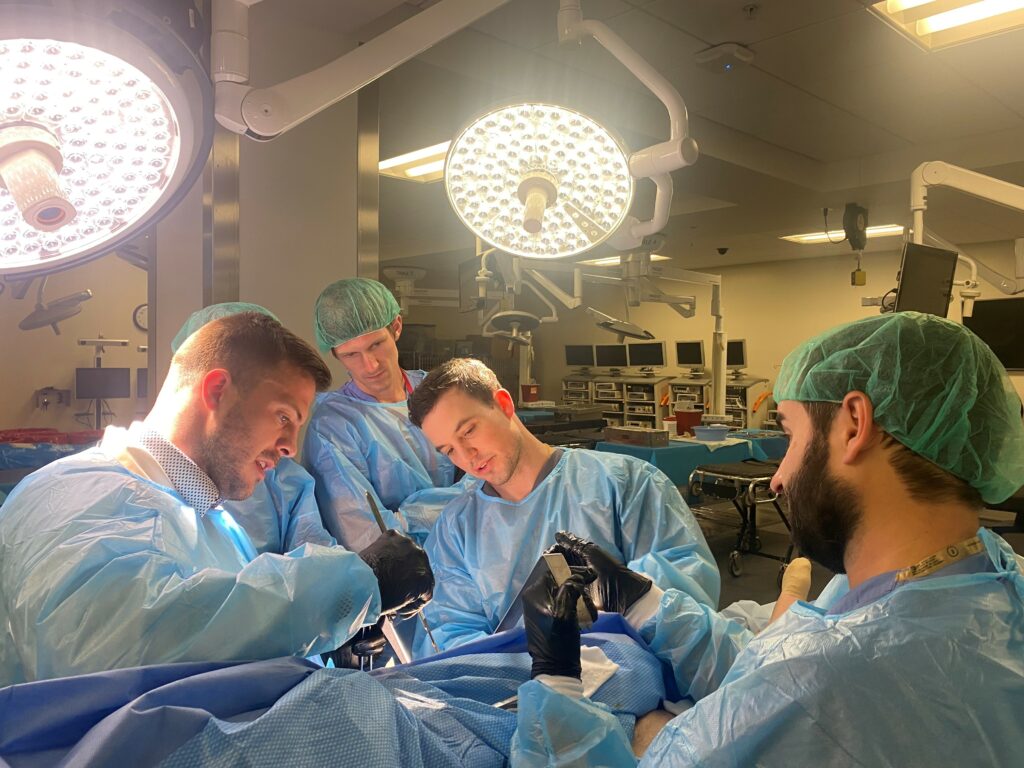“For a while, I wasn’t even sure I’d use my left arm or left leg again,” explains Campbell Clinic patient, Katina Lewis, 50, following 18 months under Dr. Chris Cosgrove’s care at Regional One Health due to a horrendous car wreck. “They talked me through (the process) and prepared me for what I had to endure. That built trust.”
Lewis is one of thousands of patients who encounter Campbell Clinic staff and residents at Regional One Health following a traumatic incident. This team—and the care they deliver—has a profound impact on surgeon training and on the patients they serve.
“What makes our program unique is the constant deluge of high-energy, complex trauma that is seen in few other places around the country,” Campbell Clinic’s Dr. Cosgrove explained. “The few trauma centers that consistently do this volume of work typically also have a large number of orthopaedic trauma fellows. With only one fellow at our program, our residents are expected to achieve a high degree of surgical prowess.”
The 40 residents’ trauma training is a cornerstone of the residency program. Each resident has a three-month trauma rotation during each of their five years. “So, in total, almost a quarter of their residency is spent at Regional One,” Cosgrove said.
The flood of patients forces residents to coordinate closely with other physicians, he said. “This experience has helped me learn how to make clinical and operative decisions in stressful situations,” said Dr. Clayton Wing, senior resident. Both uninsured and underinsured patients are served, many of whom have minimal access to health care and may have chronic illnesses.
Campbell Clinic trauma surgeon, Dr. John Weinlein, explains, “Teaching residents and fellows allows us to have an exponential impact on the community and patients’ well-being that we could not have achieved just being involved in direct patient care.”
While working at Regional One, a Level I Trauma Center, resident Dr. David Cooper learned how to perform surgery. “It has made me a very competent surgeon independently. If you’ve never had this kind of experience, when you get out (of residency) and are starting to practice, then I think that can be a big adjustment for a lot of people,” Cooper said. “But I’m already very comfortable performing surgery.”
The challenging experience teaches skills and fundamentals that the young doctors can apply anywhere, regardless of their subspecialty in the future.
Gunshot and knife wounds, car and motorcycle accidents, and industrial accidents are trauma situations that Campbell Clinic residents encounter daily. A bullet can hit any bone anywhere and cause unusual fractures that can be difficult or more challenging to fix,” Cooper said.
The trauma program began in 1983, when Campbell Clinic, under the leadership of Dr. Toney Russell (class of 1980), helped launch the Elvis Presley Trauma Center within Regional One. The center was modeled after the ground-breaking Shock Trauma Center at the University of Maryland Medical Center in Baltimore, MD.
“This was the first time that complex trauma could be referred to and treated by specialist surgeons who were trained, ready to go, and able to offer patients the best chance of survival and recovery,” Russell said.
While the trauma environment is very fast paced and intense, it’s one where lasting relationships with patients are created.
Nancy Antone, 72, is another one of our grateful patients. She was working in her yard when she fell in late 2022, breaking the top of her right leg’s femur. During the next year, she underwent five surgeries—once to implant a metal rod, once to address an E. coli infection, a third operation to replace the incorrectly situated rod with an antibiotic one, a fourth operation to implant an all-new metal rod, then finally a knee replacement. After her original operation at Baptist-Desoto, Antone consulted with Dr. William Mihalko, then was under the care of Drs. Cosgrove and Gregory Dabov.
“It was a rough year,” said Antone, who was wheelchair bound and caught COVID during the ordeal. “I could have lost my leg. I could have lost my life if Dr. Mihalko had not seen the problem. I am so thankful to be walking.”
